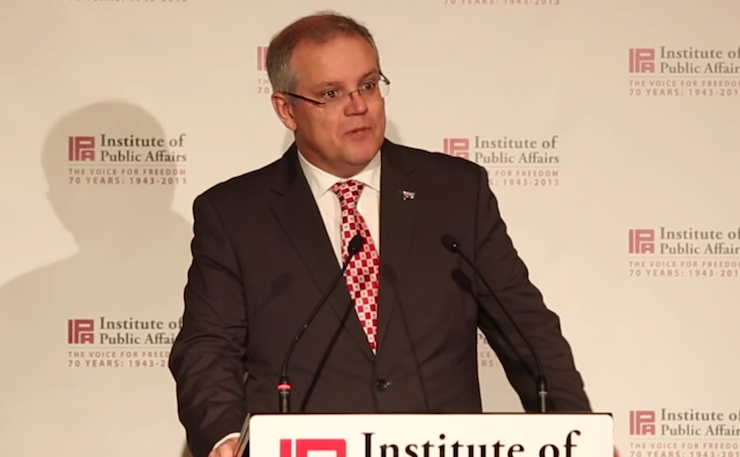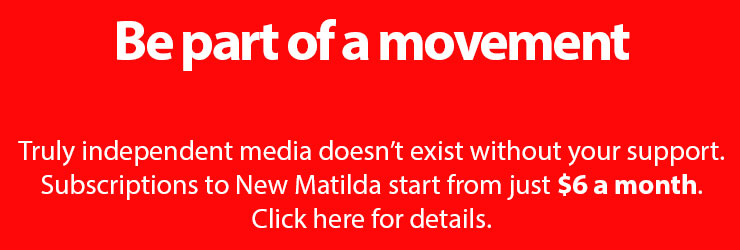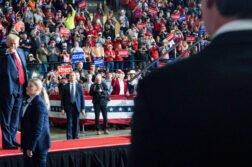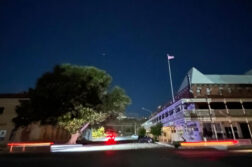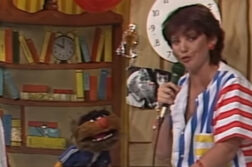Morrison and Cormann have launched a major attack on Labor’s costings, accusing the party of threatening to blow the federal budget. Given the approach the Coalition took to the 2013 election, and the damage they have done to the nation’s bottom line since, it’s a bold feat of hypocrisy even by Canberra standards, writes Ben Eltham.
A headline in the Guardian today had one of my favourite phrases in politics: the good old-fashioned “black hole.”
According to the Coalition, Labor has a “black hole” in its costings. Depending whether you believe the Coalition or not, the total blow out in Labor’s costings could be $67 billion, or even as much as $199 billion over the next decade.
A media release issued by Treasurer Scott Morrison and Finance Minister Mathias Cormann today claimed that, “over the next four years, using consistent methodologies with the Budget, Labor have identified $16 billion in budget improvements, including $14 billion in higher taxes and just $2 billion in savings.”
But Labor has blocked Coalition-sponsored savings of over $18 billion in the Senate, claims the government. This means the ALP is $2 billion behind even before we consider new spending promises – which the government puts at $30 billion. Finally, Morrison and Cormann argue, “there are $35 billion in savings measures that the Government has been able to bank, but which Labor says needs to be restored as spending.”
The cumulative deficit (using the Coalition’s assumptions) is $67 billion over the forward estimates. The Coalition is calling it – you guessed it – a “black hole”. The hard-working photo editors at The Daily Telegraph responded in their usual fashion, photoshopping Bill Shorten to look like Willy Wonka.
As always when politicians throw around dollar figures, it all sounds very serious. And Labor delivered a string of budget deficits when in office, from 2009 to 2013. So, on past fiscal performance, there is some substance to the Coalition’s attack.
Labor points out that nearly all of its policies have been costed by the Parliamentary Budget Office. Policy savings include many billions in savings to be delivered through changes to negative gearing, superannuation tax concessions, and not proceeding with the government’s promised $48 billion of company tax cuts. Quite remarkably, the government appears to have simply assumed Labor will spend $19 billion extra on foreign aid; Labor says the figure is actually $224 million. As shadow Finance minister Tony Burke joked this afternoon, “they presented a figure of $224 million, got out the liquid paper and said ‘Oh look, it’s $19 billion!'”
So how can you judge the two major parties on their budget performance?
The first thing to say is: why should we care? Australia has low (if rising) net debt. We are rich and stable, with plenty of ability to pay back the modest amount our government has borrowed. Our AAA credit rating and sound public finances mean we are paying just 2.5 per cent interest to international bond holders for our government borrowing. As this chart from the Reserve Bank shows, that’s pretty much the lowest ever.
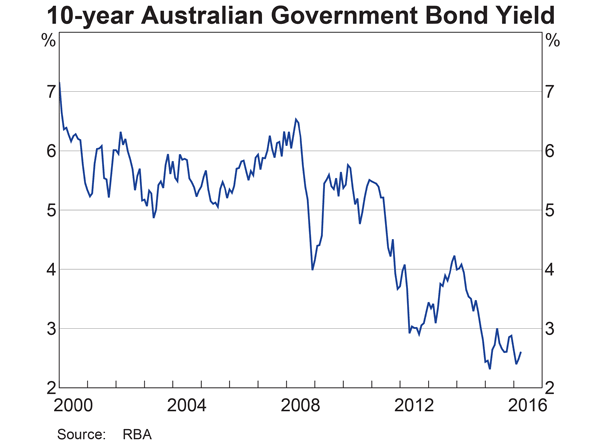
So, while we are running a deficit and running up government debt, it’s pretty manageable at the moment.
Australia’s budget is in deficit for essentially one reason: the federal government spends more than it raises in tax revenue. In international comparisons, both our spending and tax are low as a proportion of the overall economy. European countries like France and Denmark spend twice as much as we do as a percentage of their economies, and no-one thinks France or Denmark are terrible places to live in. Modest increases to taxation and some fiscal discipline should be enough to get the budget back into surplus.
Indeed, there’s good reason to believe that a small deficit like the one we’re currently running is good for the economy, which is starting to stagnate. With the Reserve Bank worried enough to lower interest rates on budget day, there is clearly a need for more fiscal stimulus, not less.
The way to do this, as most economists would probably agree, is by increasing capital investment on infrastructure. Given how cheap it is to borrow on international bond markets, investing in productive infrastructure is pretty much a guaranteed way to increase growth in the longer term. Which makes it all the stranger that the Coalition is doing so little of it.
But leaving aside the macro-economics, how seriously should we take the Coalition’s assertions that it is the better party to manage the budget? Not very, it turns out.
The graph below is very simple, but it tells you something interesting.
The figures are from the 2013 and 2016 Pre-Election Economic and Fiscal Outlooks – the budget papers prepared at the start of an election campaign by the Treasury. They are not affected by government spin in the way that federal budgets can be. As a result, they are the most transparent budget figures we have available.
The figures show that the budget deficit is worse today, after nearly three years of a Coalition government, than it was when Labor left office. Far from repairing the budget, as it has repeatedly claimed to, the Coalition has seen the deficit get worse.
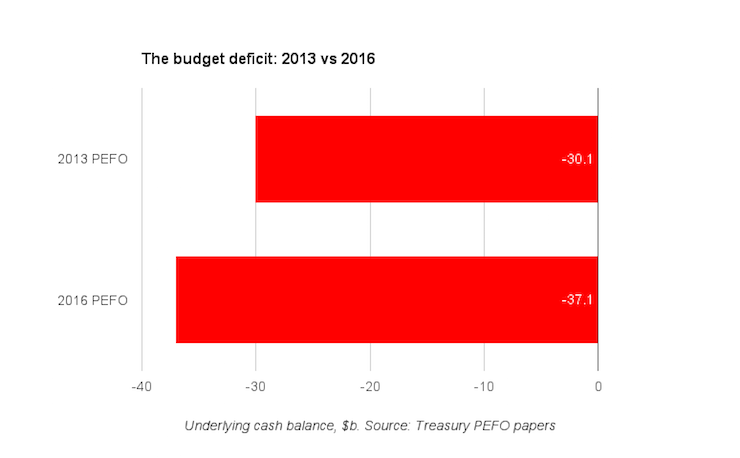
So, no, the Coalition has not been a better manager of the budget than Labor. The budget deficit has blown out under both Joe Hockey and Scott Morrison.
The reasons are varied, but they come down to two factors: anaemic revenue and strong spending. On the revenue side, tax receipts have consistently been revised downwards by the Treasury, as low nominal growth and falling commodity prices have punched a hole in company profits and ordinary wages. On the spending side, and despite all the spending cuts to health, education and welfare, the Coalition has not been particularly disciplined, committing to a massive spending splurge in defence. Government spending is actually higher in 2016, under the Coalition, than it was in 2013, under Labor.
The Coalition’s claim about Labor’s supposedly “uncosted” policies is particularly hypocritical. Just three years ago, Tony Abbott and Joe Hockey waited until 48 hours before the 2013 election to release the Coalition’s costings. This left no meaningful period for analysts and journalists to read and consider the costings – let alone ordinary voters.
The Coalition’s 2013 costings document was a risible eight pages. It was incomplete: costings for the National Broadband Network, the Direct Action climate policy and for border protection were either fudged or left out altogether. Perhaps that was just as well – after all, the Coalition went on to break most of its election promises within months anyway. The next time you hear this government complain about Labor’s dodgy figures, remember their dishonesty three years ago.
In 2016, Labor under Bill Shorten and Chris Bowen has prepared one of the most detailed and thorough set of costed policies ever put forward by an opposition. That doesn’t mean we shouldn’t scrutinise Labor’s figures. Some of their promises, particularly around climate change, do look overly optimistic.
But if we are talking numbers, let’s listen to what they’re telling us. Labor’s figures are sounder than the Coalition’s.
In the meantime, perhaps it’s time we retired the cliche of the “black hole”. Such massive gravitational anomalies can distort the fabric of space, time … and the truth.
Donate To New Matilda
New Matilda is a small, independent media outlet. We survive through reader contributions, and never losing a lawsuit. If you got something from this article, giving something back helps us to continue speaking truth to power. Every little bit counts.

